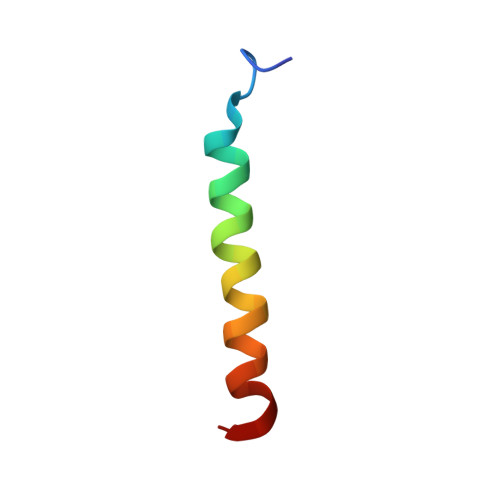Flipping in the Pore: Discovery of Dual Inhibitors That Bind in Different Orientations to the Wild-Type versus the Amantadine-Resistant S31N Mutant of the Influenza A Virus M2 Proton Channel.
Wu, Y., Canturk, B., Jo, H., Ma, C., Gianti, E., Klein, M.L., Pinto, L.H., Lamb, R.A., Fiorin, G., Wang, J., DeGrado, W.F.(2014) J Am Chem Soc 136: 17987-17995
- PubMed: 25470189
- DOI: https://doi.org/10.1021/ja508461m
- Primary Citation of Related Structures:
2MUV, 2MUW - PubMed Abstract:
Influenza virus infections lead to numerous deaths and millions of hospitalizations each year. One challenge facing anti-influenza drug development is the heterogeneity of the circulating influenza viruses, which comprise several strains with variable susceptibility to antiviral drugs. For example, the wild-type (WT) influenza A viruses, such as the seasonal H1N1, tend to be sensitive to antiviral drugs, amantadine and rimantadine, while the S31N mutant viruses, such as the pandemic 2009 H1N1 (H1N1pdm09) and seasonal H3N2, are resistant to this class of drugs. Thus, drugs targeting both WT and the S31N mutant are highly desired. We report our design of a novel class of dual inhibitors along with their ion channel blockage and antiviral activities. The potency of the most active compound 11 in inhibiting WT and the S31N mutant influenza viruses is comparable with that of amantadine in inhibiting WT influenza virus. Solution NMR studies and molecular dynamics (MD) simulations of drug-M2 interactions supported our design hypothesis: namely, the dual inhibitor binds in the WT M2 channel with an aromatic group facing down toward the C-terminus, while the same drug binds in the S31N M2 channel with its aromatic group facing up toward the N-terminus. The flip-flop mode of drug binding correlates with the structure-activity relationship (SAR) and has paved the way for the next round of rational design of broad-spectrum antiviral drugs.
- Department of Pharmaceutical Chemistry, University of California , Mission Bay Box 3122, San Francisco, California 94158, United States.
Organizational Affiliation:

















